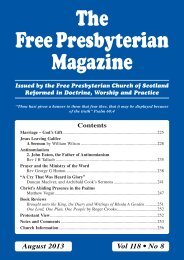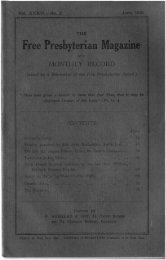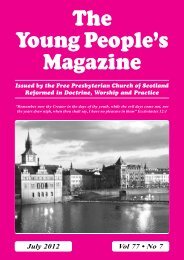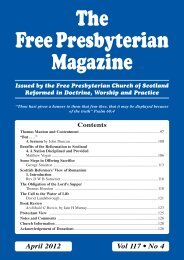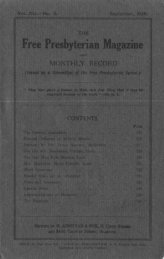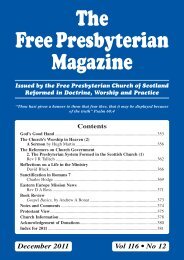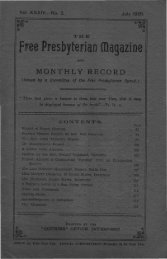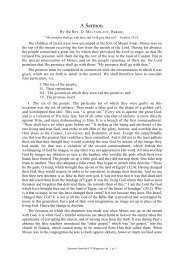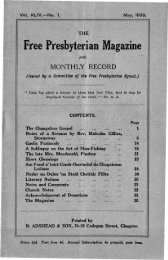March - the Free Presbyterian church of Scotland
March - the Free Presbyterian church of Scotland
March - the Free Presbyterian church of Scotland
Create successful ePaper yourself
Turn your PDF publications into a flip-book with our unique Google optimized e-Paper software.
The Early Scottish Reformation 75labourers left <strong>the</strong>ir fields, women came out <strong>of</strong> every poor cottage, and allga<strong>the</strong>red about him respectfully. Priests, citizens from a neighbouring town,women <strong>of</strong> rank and nobles – people <strong>of</strong> all classes – met toge<strong>the</strong>r <strong>the</strong>re. Patrickreceived <strong>the</strong>m with a kindly smile. He addressed to <strong>the</strong>m that first word <strong>of</strong><strong>the</strong> gospel: Be converted! But he also pointed out <strong>the</strong> errors <strong>of</strong> <strong>the</strong> RomanChurch. His hearers returned, astonished at his knowledge <strong>of</strong> <strong>the</strong> Scriptures,and those who were touched by <strong>the</strong> salvation which he proclaimed increasedin number from day to day.He soon began to set forth <strong>the</strong> gospel in lowly <strong>church</strong>es in neighbouringvillages; <strong>the</strong>n he grew bolder and preached in <strong>the</strong> beautiful sanctuary <strong>of</strong> StMichael, at Linlithgow, in <strong>the</strong> midst <strong>of</strong> <strong>the</strong> rich altars. No sooner had <strong>the</strong>report <strong>of</strong> his preaching begun to get abroad than everyone wanted to hearhim. The name he bore, his learning and his piety drew about him each daya larger number <strong>of</strong> hearers; for a long time such a crowd had not been seenflocking to <strong>church</strong>. Members <strong>of</strong> <strong>the</strong> royal family and <strong>the</strong> most prominentnobles <strong>of</strong> <strong>the</strong> kingdom united with <strong>the</strong> citizens in <strong>the</strong> <strong>church</strong> <strong>of</strong> Linlithgow.Among his hearers was a young maiden <strong>of</strong> noble birth, who with joyreceived <strong>the</strong> good news <strong>of</strong> salvation. Hamilton recognised in her a soul akinto his own. He had adopted Lu<strong>the</strong>r’s principles on marriage. “My fa<strong>the</strong>r andmo<strong>the</strong>r”, said Lu<strong>the</strong>r one day, “lived in <strong>the</strong> holy state <strong>of</strong> marriage; even <strong>the</strong>patriarchs and <strong>the</strong> prophets did <strong>the</strong> same; why should not I do so? Marriageis <strong>the</strong> holiest state <strong>of</strong> all, and <strong>the</strong> celibacy <strong>of</strong> priests has been <strong>the</strong> cause <strong>of</strong>abominable sins.” However, to marry was a daring step for Hamilton. Asabbot <strong>of</strong> Fearn and one connected with <strong>the</strong> first families <strong>of</strong> <strong>Scotland</strong>, hismarriage would excite <strong>the</strong> wrath <strong>of</strong> <strong>the</strong> priests to <strong>the</strong> highest. Besides, itcalled for great decision from Patrick, and genuine sympathy from <strong>the</strong> youngwoman, to unite in marriage in sight, as it were, <strong>of</strong> <strong>the</strong> scaffold. The marriagehowever took place, probably at <strong>the</strong> beginning <strong>of</strong> 1528. It is possible thatknowledge <strong>of</strong> this union did not pass beyond <strong>the</strong> family circle.While Hamilton was preaching at Linlithgow, Archbishop Beaton was at<strong>the</strong> monastery <strong>of</strong> Dunfermline, on <strong>the</strong> o<strong>the</strong>r side <strong>of</strong> <strong>the</strong> Firth <strong>of</strong> Forth. WhenBeaton learned <strong>of</strong> <strong>the</strong> return <strong>of</strong> <strong>the</strong> young noble who had so narrowly escapedhim, he saw clearly that a missionary animated with Lu<strong>the</strong>r’s spirit, thoroughlyfamiliar with <strong>the</strong> manners <strong>of</strong> <strong>the</strong> people, and supported by <strong>the</strong> powerfulHamiltons, was a formidable adversary. Beaton was a determined enemy <strong>of</strong><strong>the</strong> gospel. Having governed <strong>Scotland</strong> during <strong>the</strong> minority <strong>of</strong> <strong>the</strong> king, he wasindignant at <strong>the</strong> thought <strong>of</strong> <strong>the</strong> troubles with which Hamilton’s preachingmenaced <strong>the</strong> Church and <strong>the</strong> realm. The clergy shared <strong>the</strong> alarm <strong>of</strong> <strong>the</strong>irhead; St Andrews especially was in a state <strong>of</strong> great agitation.The Archbishop <strong>the</strong>refore took counsel with his nephew and o<strong>the</strong>r clerics



